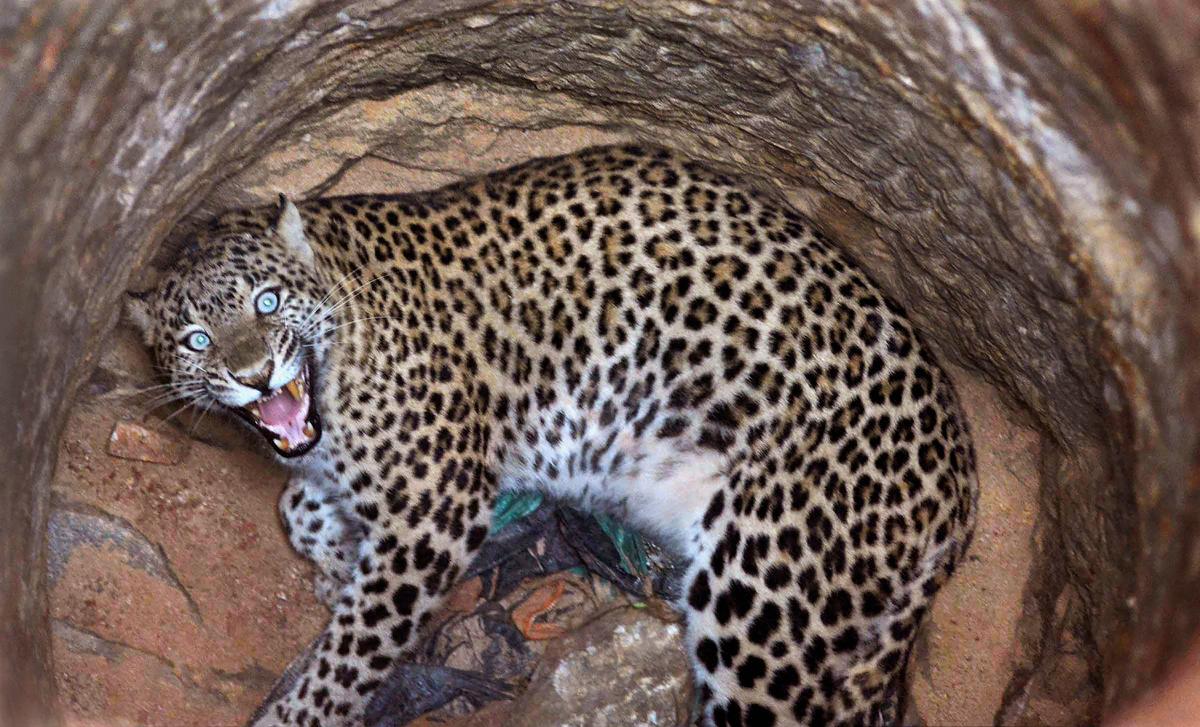Column | The leopard is far more visible now with 65% of the population existing outside protected areas
A leopard at the Bannerghatta Biological Park near Bengaluru.
| Photo Credit: Murali Kumar K.
We are watching bats. Short-nosed fruit bats diving boldly in through the arc of faint white lamps onto a bunch of ripening jahazi plantains. Louise, who had been barking her head off at them, is suddenly quiet, cowering with her cool nose at the back of my knee. All I can hear are leaves. Green leaves dancing and dry leaves skating through dark silences on the street. It is hard to believe that 100 feet downhill is a bustling thoroughfare with street lights and supermarkets.
Across the road, houses stealthily twinkle up another hillside to a lonely wood perched on the crown. This is not unusual in Guwahati. The city’s surging population overran accessible plain areas near the Brahmaputra before spreading into the forested hills and wetlands. Non-forest areas have exploded by 1,176% from 1976 onwards, at the expense of dense and moderate forests — resulting in habitat fragmentation, human-animal conflict, increased temperatures, massive erosion and cyclical flooding. In a sad parallel, since the early 2000s, Assam has lost 2,690 sq.km. and the Northeast, a massive 17,650 sq.km. of tree cover.
What does Louise know that I don’t? She is eight and has one good eye, but hers is a world of scent. When her family goes out, she knows when they are half a mile away. Dogs probably have a different concept of time to ours. One where all three tenses can exist at the same time. Perhaps the leopard is downwind, and his odour has wafted up to her. Perhaps he padded by an hour back, but his distinctive musk is lingering. Or perhaps there is a leopard right there in the shadows. Does she know if he is hungry or has fed? A leopard is the one creature that loves dogs more than humans do.
A leopard finds shelter in the verandah of a house in Guwahati in 2020.
| Photo Credit:
Ritu Raj Konwar
The unseen presence
How do I know it is a leopard? I can feel Louise’s fear. She is a Naga hill dog, proficient at hunting things smaller than herself. A fishing cat would be out of place here. A stray sambar deer would probably excite her. Two aggressive street dogs who had taken up residence in the neighbouring lane have disappeared. So too the mutts that lazed around outside the supermarket. Two nights back, there was a soft thud near the sunshade, like a pillow falling. Our daughter, who calls anything furry a ‘bow bow’, has been waking in the early hours to peek out of the window to beckon to an unseen ‘bow bow’.
We call ourselves Homo sapiens, the wise human, making up for physical weakness with reasoning. And a lack of common sense. I reason that the cat is after the dog and wary of me. It is too early for a leopard to be out and about, so near habitation. And so, I step out for a walk leaving Louise safely at home. Fifty feet later, I am frozen to the spot with the hair on the back of my neck bristling. Someone is watching me.
I cannot see much in the overgrown tangle beneath the shade of jahazi and ber. Just to be sure, I take a shot on my mobile phone with night mode on. Nothing is obvious, so I pinch the screen. And there he is, a short leap away. A grumpy spotted head buried in the grass. Nearly invisible. Nearly. Glowering at me — anything but fear in those eyes.
Thriving with humanity
A leopard stuck in a well in Guwahati before being rescued by forest officials.
| Photo Credit:
PTI
Leopards are the quintessential cat; elusive, slinking around human spaces for far longer than we thought they have. They thrive in degraded habitat and rocky scrublands, along forest margins and agricultural areas; at the edge where cities eat into forests. Unfussy and surviving on a varied diet, including dogs. They are more visible now due to the speed at which things are changing. While the latest leopard survey showed a stable trend, in many places up to 65% of the population exists outside protected areas.
The thrill of seeing a big cat up close is unmatched. It makes you feel alive like nothing else. It is also immensely humbling. To be in a forest hearing the crunch of bones in their jaws or trembling in a city street under their withering glare, is a realisation that you really aren’t on top of the food chain. What is he thinking? Can he smell Louise on me? Does he just want to cross the street? Will we ever know?
Then the reasoning makes its appearance again. Standing a few feet from a grumpy leopard in the dark, taking photos with a mobile phone isn’t the brightest thing to do. My heart is nearly bouncing out of my chest in the time it takes for my feet to get home. Louise is relieved to see me, gnawing my knee to make sure I am not a ghost.
The author is a birder and writer based in Chennai.
The fourth in a series that looks at urban spaces as havens for biodiversity and often overlooked species.
Images are for reference only.Images and contents gathered automatic from google or 3rd party sources.All rights on the images and contents are with their legal original owners.



Comments are closed, but trackbacks and pingbacks are open.